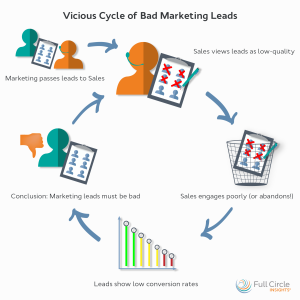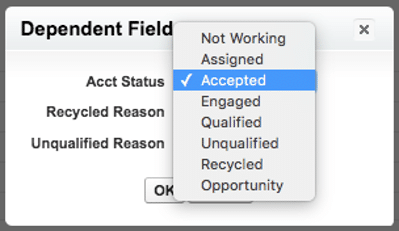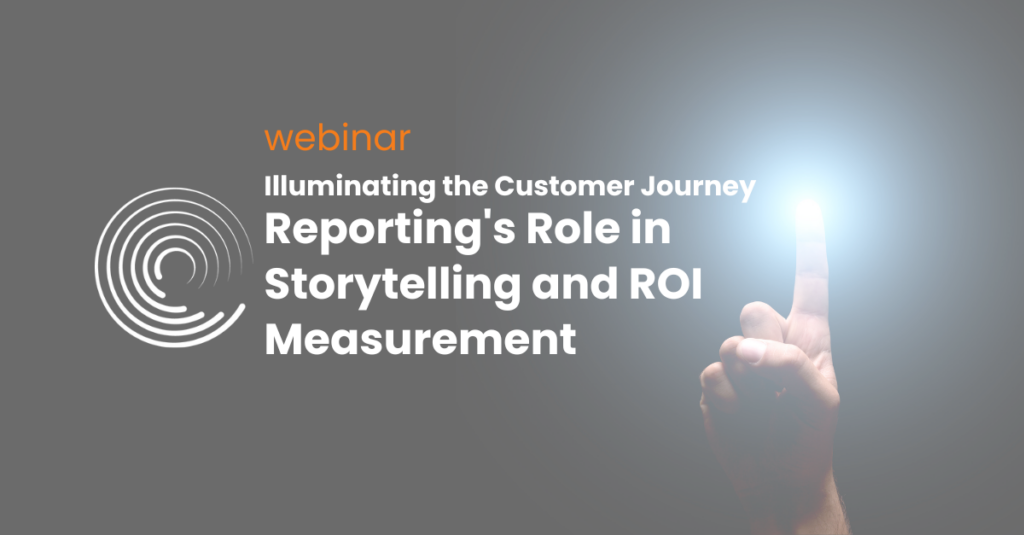In a webinar with MOCCA and DiscoverOrg, we discussed DiscoverOrg’s real-life implementation of Account-Based Marketing (ABM) strategy and the different challenges their team had to learn from and overcome. We at Full Circle Insights have also embarked on our own ABM strategy and the most strikingly common operational challenge is alignment between Marketing and Sales.
As much as we’ve always preached alignment throughout the funnel, in this uncharted world of new ABM operations, even we heard the dreaded “Oh I thought Marketing was supposed to take care of that.” This proved that we needed more alignment. Our head of marketing operations told me that she really wished the strategy was not popularly called ABM, for the ‘M’ makes people believe it is a Marketing strategy (and solely a Marketing burden). For many companies, the funnel works like this: Marketing owns leads until they become more qualified, and then Sales takes over to pursue the account. Two distinct parts of the funnel. Consider this one key takeaway:
If Sales is the voice of accounts and Marketing is the voice of leads, then the voice of the funnel is lost.
The above sounds obvious, and yet companies still approach ABM in this siloed manner. This is why we need to change our mindset and think of ABM as ABE, Account-Based Everyone.
Here are a few action items for aligning Marketing and Sales in an Account-Based Everyone strategy:
- Establish the Account Funnel (and how an account gets qualified stage-by-stage)
- Collaborate on how Sales treats prospects passed by Marketing
- Agree on who owns which CRM workflow processes that move accounts through the funnel (down and back up)
Establish the Account Funnel

In this new ABE world, you’ll need to rethink your funnel. You used to deal with leads moving down the funnel as a representation of an account. Now, in order to ensure the right account engagement with multiple individuals of the buying group, you might need to incorporate the account entity sooner. Internally, we’ve replaced the Marketing Qualified Lead (MQL) with Marketing Qualified Account (MQA). See the above image for how Full Circle Insights modifies the funnel. This is similar to many other account-based funnels you’ll see out in the industry, including SiriusDecisions’ Demand Unit Waterfall.
Now, what constitutes a Marketing Qualified Account? What are the firmographics of the account or the persona of the lead that are necessary? What behavioral prerequisites qualify an account that is merely on a target list to an engaged or qualified account? You will need to establish your “logic gates” for what qualifies an account from stage to stage. Collaborate with Sales to ensure they agree with the criteria you’ve set up.
Collaborate on the Marketing-to-Sales Handoff
In the Marketing-to-Sales handoff, there are two forces in contention: 1) Marketing wants to ensure Sales treats any qualified prospect passed over with a high-touch and personalized approach. 2) With a more time-intensive personalized approach, Sales will prioritize based on how they feel about each prospect and may give some prospects less attention. This latter behavior will be seen by Marketing as a waste of a qualified prospect, and Sales might disagree on how qualified and worthwhile the prospect was in the first place. Thus a vicious cycle occurs (see the below image).

Vicious Cycle of Bad Marketing Leads
So to combat this, 1) establish what is a qualified account (see the above Establish the Account Funnel section), and 2) create agreement on how Sales should engage with accounts. The latter involves alignment meetings where Marketing and Sales collaborate to design personalized engagements that ensure the MQAs are not wasted. Set up SLAs to enforce this on paper.
Assign CRM Workflow Process Owners for Account Data and Funnel Tracking
This might be the least glamorous part of your alignment, but it’s the sneakiest pitfall. You will want a process for inputting account data and tracking the Account Funnel in your CRM. Our customers who have ABE strategies use our Response Management in Salesforce to track the Account Funnel, and some leverage an Account Status dropdown field. See below for one example (from our Adapting Salesforce for ABM webinar with Highspot).
There are other methods as well, and any method involves only a bit of setup and collaboration between Marketing and Sales to design. But, design and setup constitute only half the equation. The final but most important aspect is assigning specific owners of the processes around the workflows that track account movement. The above example involved an owner in sales operations to manage data input for Account Statuses. You can leverage automation via workflows and scripts that fire off certain behaviors upon updating the field, but ensure that there is a human element to oversee the processes.

ABM = Account-Based Mindset
Whatever you call your Account-Based strategy, your entire organization needs to understand that it is a continuous collaborative effort. Yes there will always be tension between what Marketing wants to do and what Sales wants to do. It’s healthy. But, the benefits of re-orienting your business approach get shared by both Marketing and Sales, so the burden should be shared by both Marketing and Sales.
For more, check out our ABM Success Metrics guide and our webinar with Highspot, Adapting Salesforce for an Account-Based Strategy.



